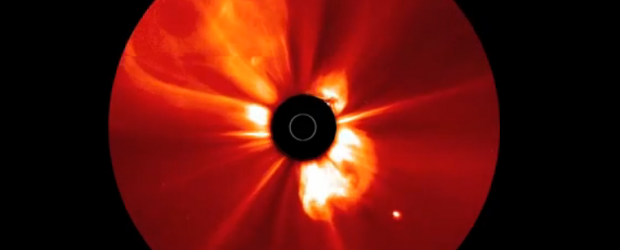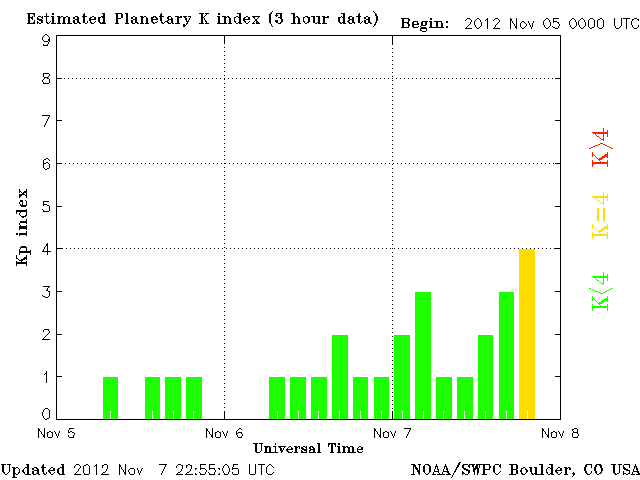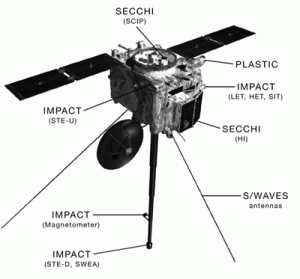Source: The Watchers - By Adonai, 11/08/12

The Sun produced a series of at least eight coronal mass ejections (CMEs) over a two-day period (November, 2-4, 2012). Some of them overlapped each other as the Sun burst some of them into space in a rapid-fire style. The series was taken by the STEREO Ahead spacecraft with its COR2 coronagraph, in which the Sun is blocked out by the black disk (Sun represented by the white circle) so that we can observe activity in the corona. These expanding clouds of charged particles also carry magnetic field into space. The bright object moving from left to right below the Sun is the planet Mercury.
Geomagnetic storm in progress (November 7, 2012)
Space Weather Message Code: ALTK04
Serial Number: 1617 Issue Time: 2012 Nov 07 21:01 UTC
ALERT: Geomagnetic K-index of 4
Threshold Reached: 2012 Nov 07 21:00 UTC
Synoptic Period: 18:00-21:00 UTC Active Warning: Yes
Potential Impacts: Area of impact primarily poleward of 65 degrees Geomagnetic Latitude.
Induced Currents – Weak power grid fluctuations can occur.
Aurora – Aurora may be visible at high latitudes such as Canada and Alaska.
Read our earlier report: Three CMEs observed on western limb, one could be geoeffective
About STEREO mission
STEREO (Solar TErrestrial RElations Observatory) is the third mission in NASA’s Solar Terrestrial Probes program (STP). The mission, launched in October 2006, has provided a unique and revolutionary view of the Sun-Earth System. The two nearly identical observatories – one ahead of Earth in its orbit, the other trailing behind – have traced the flow of energy and matter from the Sun to Earth. STEREO has revealed the 3D structure of coronal mass ejections; violent eruptions of matter from the sun that can disrupt satellites and power grids, and help us understand why they happen. STEREO is a key addition to the fleet of space weather detection satellites by providing more accurate alerts for the arrival time of Earth-directed solar ejections with its unique side-viewing perspective.
The mission started in February 2011, and is suppose to continue for the next 8 years. The mission provided first ever 360 degree view of a star — our own Sun. By combining images from NASA’s Solar Terrestrial Relations Observatory (STEREO) Ahead and Behind spacecraft, together with images from NASA’s Solar Dynamic Observatory (SDO) satellite, a complete map of the solar globe can be formed. Previous to the STEREO mission, astronomers could only see the side of the Sun facing Earth, and had little knowledge of what happened to solar features after they rotated out of view.
STEREO is able to accomplish this feat because of the unique orbits of its two spacecraft. Each spacecraft is in its own orbit about the Sun (a heliocentric orbit) with orbital parameters which differ just slightly from those of Earth. It’s these slight differences which make all the difference. The STEREO-Ahead spacecraft has an orbit which is a little bit closer to the Sun than Earth, and therefore orbits a little bit faster. STEREO-Behind, on the other hand, has an orbit just slightly outside Earth’s, and is thus a little bit slower. The end result is that each spacecraft seems to slowly drift in opposite directions away from Earth by about 22 degrees per year, as illustrated below. (more on STEREO mission here)




